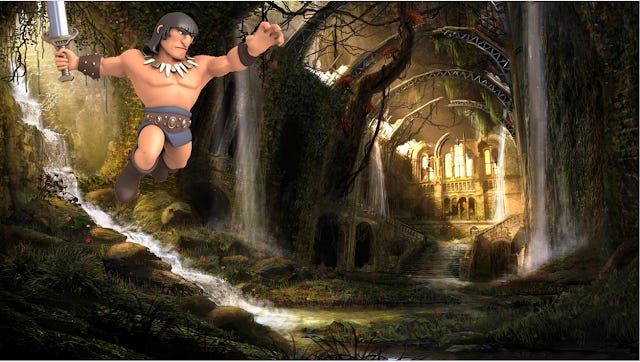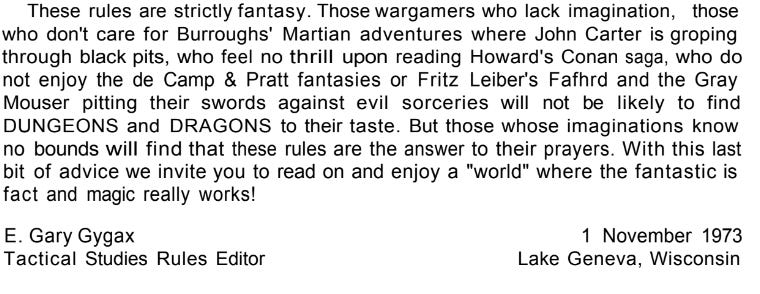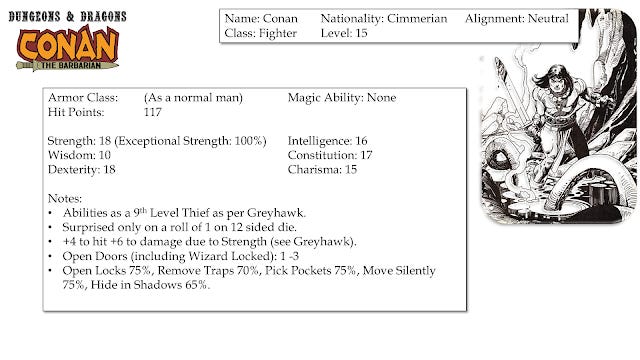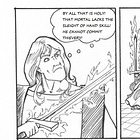
Sword & Sorcery and Conan as Continuing Inspiration for D&D
The fiction of Robert E. Howard, and the stories of Conan in particular, were among the stories that inspired the creation of the earliest editions Dungeons & Dragons role playing game. Robert E. Howard’s writings are referenced in Gary Gygax’s introduction to Dungeons & Dragons’ original Little Brown Books. It is second only to Edgar Rice Burroughs’ Martian tales of John Carter in the short list of stories one ought to be inspired by if they are the appropriately imaginative type worthy to play D&D.
Most of the recommended stories are of the Sword & Sorcery genre, though Burroughs is strongly in the Planetary Romance genre and I’ve got a piece in the editing stage about what the major differences between those genre are. The game has since developed along lines that moved it away from its early Sword & Sorcery roots through various phases and back again as the game has become its own genre of Fantasy fiction. One might be more likely to hear a new fantasy novel described as “like D&D” than to hear “D&D is like Conan stories with friends.”
You can see the influence of various fantasy authors in the tone and style of the early campaign settings. The early Greyhawk campaign was very much a fusion of Howard, Leiber, Vance, and Poul Anderson. David Arneson’s Blackmoor added even more Vance and added more than a dash of Burroughs and Science Fantasy. D&D's "The Known World," my own favorite setting, spiced things up by adding direct references to Clark Ashton Smith to the mix.
While the official worlds and settings published by TSR reflected the entirety of Fantasy fiction, the game as played by me and my friends was very Tolkienesque. The inclusion of Elves, Dwarves, Hobbits (later called Halflings), inspired a many gaming groups to have campaigns that mirrored the exploration of Moria. With the purchase of The Forgotten Realms and the development and publication of The Dragonlance modules, TSR began producing settings that were more directly Tolkienesque in execution, even as they demonstrated the unique imaginations of their creators.
However, D&D never left its Sword & Sorcery roots entirely. The publication of the Dark Sun setting, a mashup of Howard, Vance, and Burroughs is one of the best demonstrations of this argument. It was a dark and brooding setting filled with the kind of conflict one expects in a Howard or Lin Carter story, straight down to having “Dragon Kings.”
D&D expanded beyond Sword & Sorcery and Tolkien influences with the wildly imaginative Planescape, the space hamster infused Spelljammer, and the dark Fairy Tale inspired Birthright settings. As the number of settings expanded, so too did the options for player character type. The publication of so many divergent settings, with very little stylistic overlap, is one of the reasons that Ben Riggs gives for TSR’s financial troubles in the 1990s. Very few people bought all the settings and each cannibalized some audience away from other settings. Some DMs smashed all of these settings together in a way that presaged the eventual creation of a D&D genre.
D&D as Fantasy is a genre that is wilder and more patchwork than those who want to argue that D&D is "Tolkien based" fantasy adventure, but it’s a Fantasy genre that wasn’t fully realized until Keith Baker’s Eberron setting. That setting might have a particular pulpy tone, but it made sure to incorporate “All of D&D” into that setting. Greyhawk, Dragonlance, Dark Sun, and Blackmoor each had milieu limitations as to which D&D options fit in the setting. For example, there are no werewolves in Dragonlance. Planescape, Mystara, and Spelljammer were more open, but their ecumenical and cosmopolitan fantasy hadn’t caught on yet. That changed with Eberron and then again with 4th Edition, Pathfinder, and the rise of Critical Role.
Tolkien's influence on Fantasy and D&D is undeniable, but his world isn't filled with Dragonborn, Changelings, Living Constructs built for war who are now sentient beings, and races specifically bred to host Entities from the Realm of Dreams. Those are all races common in modern D&D sessions. The game was designed with Sword and Sorcery sensibilities, where Humans were meant to be the most common species played, but it has become something more. It is its own thing, and yet in that gonzo amalgamation of a vast array of Fantasy fiction, the game has in some ways retained a closer connection to its early Sword and Sorcery roots than to being an "Elf Game." The Sword & Sorcery fiction that inspired D&D was freeform. It was in many ways genre-free, in the sense that anything was possible. Before there was an Appendix N (the list of inspirational fiction in the AD&D Dungeon Master's Guide), there was this introduction the aforementioned "Little Brown Books":
A quick look through that list sees fiction that includes airships that fly by the power of the 8th Ray to propel themselves through the sky at high speeds, adventures where people are transported to the fantastic world of Spencer's Faerie Queene by thinking of mathematical equations, dark and polluted urban settings where the smog is as much a character as the protagonists, and tales where men of strong arms and strong wills flee in terror when they encounter frog headed demons. What you won't find in any of these stories are Elves, Dwarves, or Hobbits.
Though Appendix N has been used by many as the main argument for the primacy of Sword & Sorcery fiction, I would argue that one need look no further than the official game material produced by TSR. They included statistics for Conan and Elric in the Original Dungeons & Dragons Supplement IV (Gods, Demigods, & Heroes) and published a game based on Edgar Rice Burroughs Barsoom. Sadly the Conan and Elric material has been excised from the reprints of the Supplements and the Barsoom game is long out of print. Those IPs have moved onto other publishers.
Robert E Howard's creation has served as the inspiration for or been directly adapted by more game companies than any other. TSR adapted Conan for OD&D and AD&D and created a role playing game devoted to the character. Steve Jackson Games produced GURPS Conan. Mongoose Publishing produced a Conan series of books for 3rd Edition D&D. Modiphius is currently publishing a Conan game using their in house 2d20 game system. Beyond these licensed adaptations (though the OD&D adaptation was likely not licensed), games like Barbarians of Lemuria, Sorcerer (with its Sword & Sorcerer supplement), Carrion Lands, and Shadow of the Demon Lord all owe debts to this man of great mirth and great melancholy. Sword & Sorcery is THE major influence of fantasy role playing games and Conan IS the apotheosis of Sword & Sorcery.
Conan in Original D&D
So how well have role playing games inspired by Conan's adventures emulated him, both stylistically and mechanically? That is the central question of this series of blog posts and the answer is "depends." This blog post will focus on the version of Conan presented in Dungeons & Dragons Supplement IV: Gods, Demigods, & Heroes and later entries will examine formal and non-formal adaptations. As I mentioned earlier, the Wizards of the Coast reprint of the book lacks his entry, but I've transferred the information from that entry onto a character sheet below.
This brief entry tells us a few things about the design of Dungeons & Dragons and how good, or not good, they were at emulating a specific character from fiction. Keep in mind that the statistics were produced after the publication of the Greyhawk supplement and thus reflect the full adoption of the "alternate combat system" as the official combat system for D&D and the formal publication of the Thief class. The Thief class was created by Daniel Wagner who played D&D at Gary Switzer’s Aero Hobbies game store in Santa Monica, CA (see Daniel Wagner’s comment in the link for context). Gary Gygax took what he heard about the class and incorporated into the D&D game via a rules addition and eventual publication in the Greyhawk supplement.
The first thing that we see is that Conan is classified as a Fighter with Thief abilities, the descriptions in the actual supplement are "Fighter Ability: 15th Level" and "This Fighter of the 15th level also has the abilities of a 9th level Thief." It’s here that we already see D&D struggling to emulate a fictional character directly.
Even with the expanded Greyhawk supplement rules, the designers had to break the rules as written to emulate what they thought Conan should look like mechanically. In OD&D only demihumans like Elves and Dwarves are expressly described as being capable of having multiple classes and so Conan is described as being one class with “the abilities” of another class.
In some ways, this is an argument against the development of a Thief class at all and an argument for some way of arbitrating things like hiding or climbing walls other than dialog and DM fiat. The Thief class was designed to emulate characters like The Grey Mouser, but the Fighting Man class from the D&D rulebooks could do equally well with only a few additions to the basic rules set. The creation of the Thief introduced a mechanics based mentality to the game that potentially changed how the game was played. I’ve written about the mechanics based mentality in my February linked below.
I'm not opposed to having a Thief class, and thing the class has evolved in interesting ways over the years, but I do think that the game would have been perfectly fine had it stayed with Fighters, Magic Users, and Clerics as the only actual classes. Given that the Mouser and Fafhrd were both fantastic swordsmen, but also "thieves," having a Thief class that doesn't fight particularly well seems an odd way to go. This is especially true given how bad Thieves are at thieving. Don't even get me started on what effect it has on realism that thieves have the ability to climb walls, hide in shadows, and move silently when no one else does.
Had there been no Thief class in the Greyhawk supplement, Conan would likely have been described only as a Fighter. As it is, the authors demonstrated that the emulation of fictional heroes required modifying the rules as written, even for a character as simple to emulate as Conan.
For all the talk of violating the rules as written, you might think that I think the authors have done something terrible. Quite the contrary. I think that by demonstrating that even a character as basic in archetype as Conan requires house ruling, the authors of Gods, Demigods, & Heroes are telling DMs to open up their game play and to not be restricted by the rules as written. As Timothy Kask writes in the introduction to the book, "As we've said time and time again, the 'rules' were never meant to be more than guidelines; not even true 'rules.'" OD&D rules were meant to facilitate play and not restrict it. The arguments for "RAW" play don't get heavily promoted by TSR until the publication of AD&D, and even then are for the purpose of tournament play and not house play.
Gods, Demigods, & Heroes is an odd and wonderful book. One the one hand it seeks to show DMs how they can modify the rules to create the types of games that best fit their gaming group. On the other hand, it was written as a "last attempt to delineate the absurdity of 40+ level characters." It was meant to show players that even the "most powerful" weren't of ridiculously high levels and that campaigns could be fun at lower level play. And yet, it became for many a menagerie of monsters to be slain by player characters; having the opposite effect it intended.
All of that aside, in a book filled with mythologies the authors only included two that were not "real world" pantheons. They chose to give statistics for the worlds of Conan and of Elric, two sides of the same coin. Two of the best characters in Sword & Sorcery fiction. In doing so, the demonstrated how central Conan and Sword & Sorcery are to the creation of D&D.
Conan would appear in TSR products again a decade later with statistics in two different game systems, but that's a discussion for a future.








I've never thought of Thief as a class. I've always considered thief as skills you could pick up. Dungeon explorers should be able to find traps (Ala Indiana Jones), try to disarm them, and attempt to pick locks. A fighter could learn them, a cleric could learn them, a mage could learn them, but that wouldn't make them thieves.
Very good read and a good walk through history and the design of early D&D. I’ve been listening to Conan via audiobook off and on and the parallels between his adventures and that of an early D&D Fighter/adventurer is not far off from one another.
I’d make the argument that I ought to sit and meditate on Conan more in my planning sessions for my campaigns.